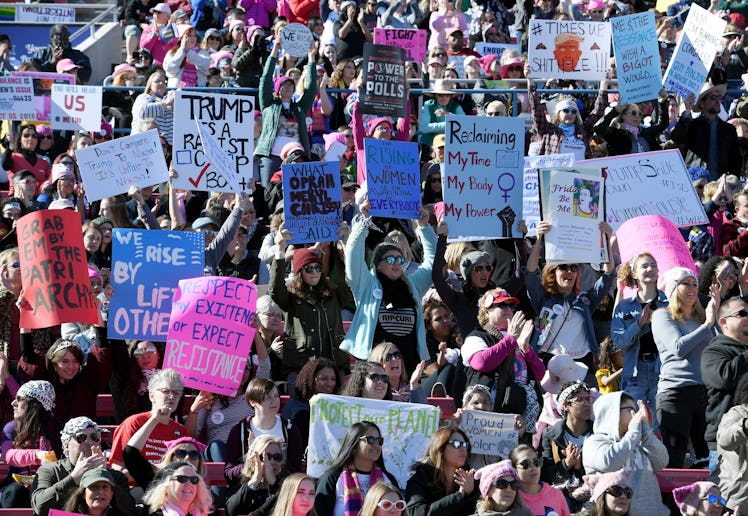
Women Made History In The 2018 Elections For One Big, Important Reason
Tuesday, Nov. 6 was anticipated to be one of the most pivotal elections in modern U.S. history. With political tensions high, the elections were seen as a litmus test for what direction the country might go — and who would chart that course. The underlying question: Was 2018 another "Year of the Woman?" While the answer is in the eye of the beholder, there's no question that gender was an undercurrent in the "wave" that swept this year's midterm election cycle.
A roundup of how women candidates fared on Tuesday shows a robust result. According to the Center for American Women in Politics (CAWP), a total of 96 women were elected to the House of Representatives, shattering the previous record of 85. In the Senate, 12 women were elected, bringing the new total up to 22; one less than the current amount and record of 23. And in governorships, women picked up three seats, bringing their new total up to nine, tying for the previous record. In sum: This year's midterm election just set a new record for the number of women in Congress, at 117 representatives between the House and Senate.
While that's still nowhere close to proportional representation — this new total means women are still just 21.8 percent of Congress — there's little question that the needle moved in the direction of normalizing women in politics.
Even before Tuesday, this year was already historic in that a record number of women — especially LGBTQ and women of color — ran for office to begin with. As The Guardian's David Smith puts it: "This was the first time in US history that most of a major party's nominees were not white men. It was the year of the woman." Politico reported in September that the party had nominated 180 women in House primaries, up from the previous record of 120. The party also nominated 133 people of color.
It's also worth noting how many of the women who ran, and won, were first-time candidates taking on male incumbents — overall, the party nominated 158 first-time candidates. A handful of those women, all of them Democrats, out-fundraised the men in power they were looking to unseat — a feat for any challenger regardless of party of gender. What's even more interesting is that the crop of women joining Congress is a diverse group itself. Thanks to Tuesday's results, the 116th Congress will include the youngest woman to serve in that House (Alexandria Ocasio-Cortez in New York, at age 29), the first two Native American women (Sharice Davids of Kansas and Deb Haaland of New Mexico), and the first two Muslim American women (Rashida Tlaib of Michigan and Ilhan Omar of Minnesota).
"Yesterday was clearly the year of the woman," Democratic National Committee Chairman Tom Perez told CNN on Wednesday.
Across social and other media, many were labeling it the Year of the Woman thanks to Tuesday's strong showing.
As a quick recap on where the term "Year of the Woman" came from: It was first coined in 1992 when a wave of women surged into the national political sphere following the shocking confirmation of Supreme Court Justice Clarence Thomas in 1991, despite a damning testimony from Anita Hill, a former employee who'd had accused him of sexual harassment. Thomas denied the allegations at the time, and representatives of the Supreme Court Justice did not reply to Elite Daily's request for additional comment. The shocking upset galvanized women to change the face of those in power, and the next year — also a midterm election year — a record-breaking number of women ran for and were elected to Congress.
The Clarence/Hill hearing had clear parallels to the the present-day hearing for Supreme Court Justice Brett Kavanaugh, who was confirmed to his seat in October despite testimony by Dr. Christine Blasey Ford, who alleged he'd sexually assaulted her when the two were in high school. Kavanaugh denied the allegations, and representatives for him did not reply to Elite Daily's request for additional comment. Like Thomas', Kavanaugh's confirmation was among one of many issues that, while it didn't change the crop of candidates, certainly hung over the midterm elections. It even swayed voters — like this woman, a registered Republican who voted Democratic.
Other factors that might've contributed to both a record number of women running and winning their elections were President Donald Trump, who won the presidency despite his own allegations of sexual assault and harassment (all of which he's denied, and the official White House stance is that his accusers are lying), as well as the #MeToo movement that brought the issue of sexual misconduct to the country's fore. In fact, polling earlier this year showed that sexual assault and harassment was shaping up to be a make-or-break-it issue among women voters in particular. And early results indicate that women also accounted for 52 percent of the voter turnout.
So while the circumstances may have been different in 1992 compared with 2018, the outcomes were largely similar: Women ran for office like never before, and they made noteworthy gains. Whether that amounts to a Year of the Woman is up for debate. There's still a long way to go if you're playing a numbers game, but there's no contest that the breadth of representation encompassed within those women who did win is worth its own catchy moniker. If there's one takeaway from Nov. 6, it's that the country clearly doesn't see leaders at being only old, white, and male. Not anymore.